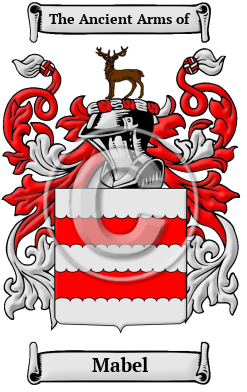| ![Show Contents]() Mabel History, Family Crest & Coats of Arms Mabel History, Family Crest & Coats of Arms
- Origins Available:
England
Etymology of MabelWhat does the name Mabel mean? Mabel is an ancient Anglo-Saxon surname that came from the female personal name Anabel, which was originally derived from the Latin word amablis, which means lovable. 1 "There is no difficulty about it. Originally it was Amable or Amabel, but very soon became Annabel, whence the Scottish Annaple and Annabella. " 2 "There is no evidence for the use of Hannibal as a Christian name in England before 1619 in Cornwall." 3 Early Origins of the Mabel familyThe surname Mabel was first found in the Hundredorum Rolls of 1273 where we found entries as a forename and surname: Amabilia (without surname), Buckinghamshire; John filius Amabilie, Huntingdonshire; and John Amable Cambridgeshire. 2 The Close Rolls listed Richard Anabilla, temp. Richard II, Mathew Hanybal, 39 Henry III (in the 39th year of King Henry III's reign), John Anable, 22 Edward III (during the 22nd year of King Edward III's reign.) 2 In Cheshire, Roger, George Anabull(e) was listed there in 1499 and 1539. Thomas Hannyball was listed in Oxfordshire in 1513 and John Anyable was listed in Suffolk in 1568. 3 Early History of the Mabel familyThis web page shows only a small excerpt of our Mabel research. Another 104 words (7 lines of text) covering the years 1166, 1256, 1275, 1282, 1504, 1513, 1515, 1520, 1523, 1531, 1792 and 1821 are included under the topic Early Mabel History in all our PDF Extended History products and printed products wherever possible. Mabel Spelling VariationsThe English language only became standardized in the last few centuries; therefore,spelling variations are common among early Anglo-Saxon names. As the form of the English language changed, even the spelling of literate people's names evolved. Mabel has been recorded under many different variations, including Annabell, Anabell, Anebelle, Annabal, Annable, Anable, Amable, Amabilis, Annible, Hunnable, Hannibal, Honeyball, Honeybell and many more. Early Notables of the Mabel familyDistinguished members of the family include Thomas Hannibal (d. 1531), English judge who was incepted in the canon law at the university of Cambridge in 1504, and the same year was installed prebendary of Gevendale in the church of York. "He was incorporated D.C.L. at Oxford in 1513, and graduated LL.D. at Cambridge, and received the appointment of vicar-general to Silvester, bishop of Worcester, in the following year. He entered the...
Another 70 words (5 lines of text) are included under the topic Early Mabel Notables in all our PDF Extended History products and printed products wherever possible. Migration of the Mabel familyFor many English families, the political and religious disarray that shrouded England made the far away New World an attractive prospect. On cramped disease-ridden ships, thousands migrated to those British colonies that would eventually become Canada and the United States. Those hardy settlers that survived the journey often went on to make important contributions to the emerging nations in which they landed. Analysis of immigration records indicates that some of the first North American immigrants bore the name Mabel or a variant listed above: Anthony Annabal, who sailed to Plymouth, Massachusetts in 1621; Jane Annable to Plymouth in 1623; John Annable to Massachusetts in 1641; Robert Annable to Massachusetts in 1690.
| Contemporary Notables of the name Mabel (post 1700) | + |
- Ina Mabel Lamson MBE (1911-1994), née Pickering, New Zealand women's cricketer for Wellington (1935-1936) and (1961-1962)
- Catherine Mabel Hukill (1910-1995), birth name of Carol Hughes, an American actress, best known for her starring roles with Gene Autry and Roy Rogers, and for her role as Dale Arden in Flash Gordon Conquers the Universe (1940)
- Dorothea Mabel Macnee BEM (1896-1984), née Henry, British socialite during the inter war years, mother of Patrick Macnee
- Ethel Mabel Raby (b. 1914), English two-time silver medalist athlete at the 1938 British Empire Games
- Mabel Mercer (1900-1984), English born cabaret singer and recipient of the Presidential Medal of Freedom
- Mabel W. Anderson, American private in the 6888th Central Postal Directory Battalion, first all-female, all-African-American battalion to server overseas
- Mabel Marie "Dolly" Staton (1932-2025), American track and field athlete, specializing in long jump and sprints, represented the United States at the 1952 Olympics
- Mabel Elizabeth Emily Wotton (1863-1927), English writer, born in London
- Mabel Josephine Mackerras (1896-1971), née Bancroft, an Australian zoologist who was awarded the Clarke Medal in 1965
- Mabel Irene Lockerby (1882-1976), Canadian artist from Montreal, Quebec, member of the Beaver Hall Group
- Harrison, Henry, Surnames of the United Kingdom: A Concise Etymological Dictionary Baltimore: Geneological Publishing Company, 2013. Print
- Bardsley, C.W, A Dictionary of English and Welsh Surnames: With Special American Instances. Wiltshire: Heraldry Today, 1901. Print. (ISBN 0-900455-44-6)
- Reaney, P.H and R.M. Wilson, A Dictionary of English Surnames. London: Routledge, 1991. Print. (ISBN 0-415-05737-X)
 |

